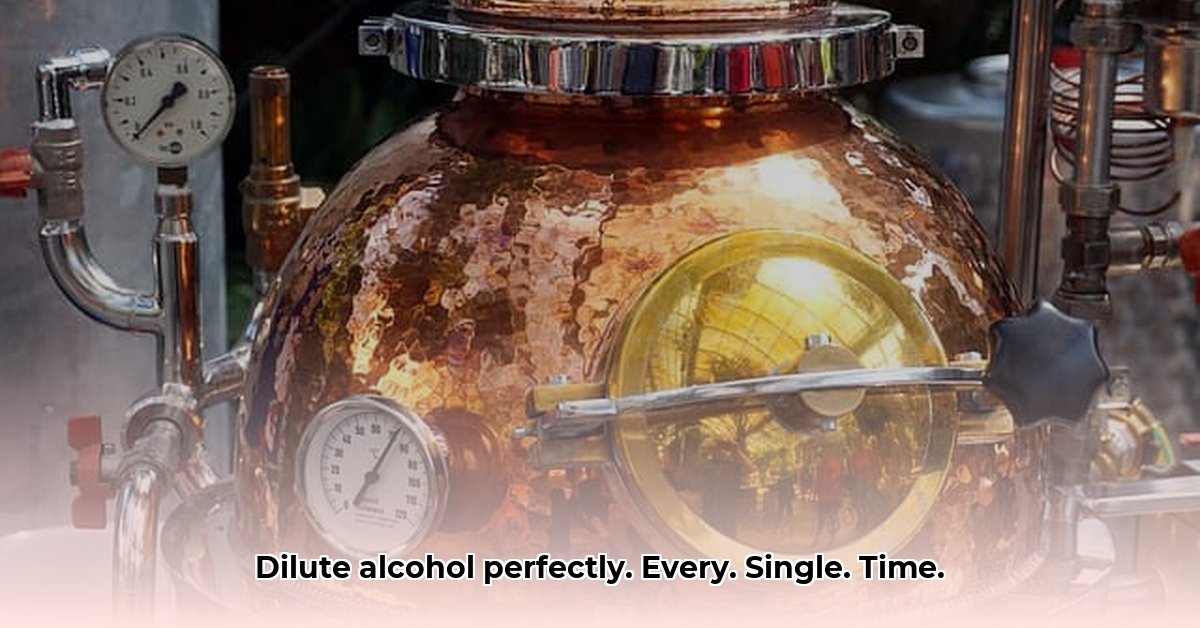Mastering Alcohol Dilution: A Comprehensive Guide
This guide provides a clear, step-by-step approach to diluting alcohol safely and effectively, whether you’re crafting the perfect cocktail, preparing a cleaning solution, or conducting a scientific experiment. We’ll cover the essential principles, safety precautions, and practical tips for achieving accurate dilutions every time.
Understanding Alcohol Concentration and Proof
Before we delve into the how-to, let’s clarify the language of alcohol concentration. “Proof” is a measure of alcohol content specific to the United States, equal to twice the Alcohol by Volume (ABV). So, an 80-proof spirit is 40% ABV. ABV, expressed as a percentage, is the universal standard, indicating the volume of alcohol in a given volume of liquid. This understanding is fundamental to precise dilution.
The Dilution Formula: C1V1 = C2V2
This simple equation is the cornerstone of alcohol dilution.
- C1: Initial concentration (ABV)
- V1: Initial volume
- C2: Desired/target concentration (ABV)
- V2: Final volume
This formula states that the amount of alcohol remains constant, even as the volume changes.
Step-by-Step Dilution Guide
- Define Your Target: Determine your desired ABV (C2).
- Measure Your Starting Solution: Accurately measure the initial volume (V1) and ABV (C1) of your alcohol.
- Calculate the Final Volume: Use the formula: V2 = (C1 * V1) / C2.
- Determine Water to Add: Subtract the initial volume from the final volume: V2 – V1 = Water to add.
- Dilute Slowly and Carefully: Always pour the alcohol into the water, stirring gently, to minimize splashing and heat generation.
Example: Diluting 100ml of 95% alcohol to 70%:
- C1: 95%
- V1: 100ml
- C2: 70%
- V2: (95 * 100) / 70 = 135.7ml (approximately)
- Water to Add: 135.7ml – 100ml = 35.7ml (approximately)
The Cross-Method: A Quick Estimation
The cross-method offers a quicker, albeit less precise, way to estimate dilution ratios.
- Write down the starting and target ABVs.
- Subtract diagonally to find the parts of alcohol and water needed.
- Use this ratio in proportion to your starting volume.
Important Note: This method doesn’t account for volume contraction and is less reliable for precise dilutions.
Alcohol Contraction: Factoring in the Shrinkage
When alcohol and water mix, the total volume decreases slightly due to molecular interactions – a phenomenon called contraction. While this is often negligible for small dilutions, it becomes relevant at higher concentrations. Some advanced online calculators incorporate contraction factors, enhancing precision. Ongoing research aims to further elucidate the specifics of this phenomenon.
Alcohol Dilution Calculator: The Digital Solution
Online alcohol dilution calculators streamline the process. Simply input your starting and target parameters, and the calculator instantly provides the required water volume, often including contraction compensation for increased accuracy.
Safety First: Handling High-Proof Alcohol
Exercising caution is paramount when working with high-proof alcohol.
- Ventilation: Work in a well-ventilated area to disperse flammable vapors.
- Fire Hazards: Keep open flames away from alcohol. High proof alcohol is extremely dangerous due to it’s flammability.
- Dilution Order: Always add alcohol to water, never the reverse, to control heat generation and minimize splashing.
- Accurate Measurement: Use precise measuring tools.
- Storage: Store diluted alcohol in sealed, labeled containers, away from heat and out of reach of children.
Practical Applications: More Than Just Cocktails
Alcohol dilution extends beyond beverages, encompassing applications like creating cleaning solutions, preparing laboratory reagents, and even adjusting the alcohol content in culinary preparations.
Beyond the Basics: Tools and Techniques
A hydrometer can verify the final ABV of your diluted solution, providing an independent check. While basic calculations suffice for most applications, awareness of factors like temperature and the specific type of alcohol can enhance precision, especially in scientific contexts.
By understanding these principles and following the guidelines presented, you can confidently and safely dilute alcohol for various purposes. Remember, responsible handling and accurate measurement are essential for achieving desired results while ensuring safety.
- Lunch Box That Fits Bento Box Neatly for Daily Use - December 5, 2025
- Japanese Lunch Bag Does Double Duty as Bento Carrier and Tote - December 4, 2025
- Your Perfect Bento Box Bag For Fresh And Tidy Meals - December 2, 2025










